Flowers Starting With F are some of the most fascinating and beautiful specimens in the world of botany.
From delicate, fragrant blossoms to vibrant and exotic blooms, there is no shortage of floral wonders to discover.
Whether you are a seasoned gardener, a lover of nature, or simply someone who appreciates the beauty of flowers, there is something truly captivating about the Flowers Starting With F.
This article will take a closer look at 15 of the most fascinating Flowers, Starting With F.
Each of these flowers has a unique story to tell, from their origins and symbolism to their growth patterns and cultivation techniques. We will explore the fascinating world of Flowers Starting With F, from the classic Freesia to the lesser-known False Solomon’s Seal and everything in between.
So, whether you want to add some new varieties to your garden or simply want to learn more about the wonderful world of flowers, read on to discover the fascinating flowers starting with F!
Why Should I Use Flowers Starting With F?
There are many reasons why you should consider using Flowers Starting With F in your garden or floral arrangements. Here are just a few:
- Variety: Flowers Starting With F encompass a wide range of species, from delicate freesias to stunning fuchsias. This means that you can easily find a flower that fits your style and preferences, whether you’re looking for something classic or unique.
- Beauty: Flowers Starting With F are some of the most beautiful and visually stunning flowers you’ll find. Their unique shapes, vibrant colors, and delicate petals are sure to add a touch of beauty and elegance to any garden or floral arrangement.
- Symbolism: Many Flowers Starting With F have symbolic meanings attached to them. For example, the freesia symbolizes innocence and friendship, while the fuchsia is associated with love and beauty. Adding these flowers to your garden or arrangements can add depth and meaning to your floral displays.
- Fragrance: Several Flowers Starting With F are known for their delightful fragrances. For example, the freesia has a sweet, citrusy scent, while the frangipani has a rich, tropical aroma. Adding these flowers to your garden or arrangements can fill the air with a delightful fragrance.
- Low Maintenance: Many Flowers Starting With F are easy to grow and maintain. For example, the flax is a hardy plant that can tolerate a wide range of growing conditions, while the foxglove is a self-seeding plant that requires minimal care. This makes them perfect for beginners or those with busy schedules.
In conclusion, Flowers Starting With F are a versatile and beautiful addition to any garden or floral arrangement. With their wide range of varieties, unique beauty, symbolism, fragrance, and low maintenance, there is no reason not to add some of these fascinating flowers to your life.
1. Freesia
The Freesia is a popular and beloved flower known for its delicate, fragrant blooms. It belongs to the Iridaceae family and is native to South Africa. Freesias come in a variety of colors, including white, pink, yellow, orange, and red, and their sweet, citrusy fragrance is one of their most distinctive features.
Planting Guide: Freesias grow from corms, which should be planted in the fall for spring blooming. Choose a site with well-draining soil and full sun to partial shade. Plant the corms about 2-3 inches deep and 3-4 inches apart, with the pointed end facing up. Water well after planting, but be careful not to overwater. Freesias can also be grown in pots or containers, which should be filled with well-draining potting mix.

Ideal Countries: Freesias can be grown in a wide range of countries with mild climates, including South Africa, Australia, New Zealand, the United States, and many countries in Europe. They thrive in Mediterranean and subtropical climates and can be grown both indoors and outdoors.
Maintenance Tips: Freesias are relatively easy to maintain, but here are some tips to help ensure their success:
- Water: Freesias require regular watering, especially during the growing season. Keep the soil consistently moist, but avoid overwatering, which can cause the corms to rot.
- Fertilizer: Fertilize freesias once a month during the growing season with a balanced, water-soluble fertilizer.
- Deadheading: Remove spent flowers regularly to encourage the plant to produce more blooms.
- Protection from Frost: Freesias are sensitive to frost, so protect them during cold weather by covering them with a layer of mulch or bringing them indoors.
- Storage: After the flowers have faded, the leaves will turn yellow and wither away. At this point, the corms can be dug up, dried, and stored in a cool, dry place until the next planting season.
In conclusion, the Freesia is a beautiful and fragrant flower that is easy to grow and maintain. With proper planting, watering, fertilizing, and maintenance, you can enjoy these lovely blooms in your garden or as part of a floral arrangement.
2. Fuchsia
The Fuchsia is a stunning, exotic flowering plant that belongs to the Onagraceae family. The plant is native to Central and South America, but it is now cultivated worldwide for its beautiful flowers. Fuchsia flowers come in a wide range of colors, including pink, purple, white, and red. The plant has distinctive, long, dangling flowers that make it a popular choice for hanging baskets and patio containers.
Planting Guide: Fuchsias are typically planted in the spring, after the last frost. They prefer well-draining soil that is rich in organic matter, and they do best in partial shade or filtered light. The plant should be placed in a location that is sheltered from strong winds. When planting, dig a hole that is slightly larger than the root ball and gently loosen the roots before planting. Water the plant well after planting, and then keep the soil consistently moist throughout the growing season.
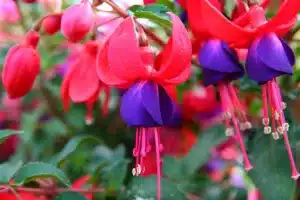
Ideal Countries: Fuchsias are grown in many countries worldwide, including the United States, Canada, the United Kingdom, Australia, and New Zealand. They prefer mild, temperate climates and do best in areas with cool summers and mild winters.
Maintenance Tips: Fuchsias require regular maintenance to ensure their continued health and beauty. Here are some tips:
- Watering: Fuchsias require consistent moisture, so water them regularly throughout the growing season. However, be careful not to overwater, as this can cause root rot.
- Fertilizing: Fuchsias benefit from regular fertilization during the growing season. Use a balanced fertilizer every two to three weeks to promote healthy growth and blooming.
- Pruning: Fuchsias should be pruned regularly to promote bushy growth and prevent legginess. Pinch back the tips of the stems regularly to encourage branching, and remove any dead or damaged growth.
- Winter Care: In colder climates, fuchsias will need to be protected during the winter months. Bring container-grown fuchsias indoors or into a sheltered location, and cover in-ground plants with a layer of mulch to protect the roots.
- Pest Control: Fuchsias are susceptible to a variety of pests, including spider mites, aphids, and whiteflies. Regularly inspect your plants for signs of infestation and treat as necessary with an appropriate insecticide.
In conclusion, the Fuchsia is a beautiful and exotic plant that requires some care and attention to thrive. With proper planting, watering, fertilizing, pruning, and pest control, you can enjoy the stunning blooms of the Fuchsia in your garden or as part of a container display.
3. Flax
The Flax plant, also known as Linum usitatissimum, is a tall, slender plant with delicate blue flowers. The plant belongs to the Linaceae family and is native to the Mediterranean region. Flax has a long history of cultivation, as it is an important source of fiber for linen textiles, as well as oil for food and other uses.
Planting Guide: Flax is typically planted in the spring in well-draining soil. The plant prefers full sun and can tolerate a wide range of soil types. When planting, sow the seeds directly into the soil, about 1/4 to 1/2 inch deep, and 1 inch apart. Flax does not require much fertilizer or water, but it is important to keep the soil moist until the plants become established. Flax grows quickly, reaching maturity in about 90 days.
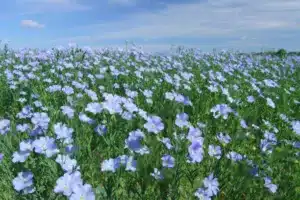
Ideal Countries: Flax is grown in many countries around the world, including Canada, the United States, China, India, and Russia. The plant thrives in cool, temperate climates and can tolerate both dry and wet conditions. Countries with a long history of flax cultivation include France, Belgium, and the Netherlands.
Maintenance Tips: Flax is a low-maintenance plant, but here are some tips to ensure its success:
- Watering: Flax does not require much water, but it is important to keep the soil moist until the plants become established. After that, the plant can tolerate dry conditions.
- Fertilizing: Flax does not require much fertilizer, as it can fix its own nitrogen. However, a light application of nitrogen-rich fertilizer can be beneficial during the early stages of growth.
- Pest Control: Flax is relatively resistant to pests and diseases. However, it can be susceptible to damping-off, a fungal disease that can cause the seedlings to die. To prevent this, ensure that the soil is well-draining and avoid overwatering.
- Harvesting: Flax is typically harvested in the summer, when the plants begin to turn yellow and the seed capsules begin to dry. The plants should be pulled up by the roots and laid out in the sun to dry. The seeds can then be threshed and cleaned.
- Rotation: Flax should be rotated with other crops to prevent disease and nutrient depletion in the soil. Ideally, flax should not be planted in the same location more than once every three to four years.
In conclusion, Flax is a versatile and low-maintenance plant that can be grown for its fiber or oil. With proper planting, watering, fertilizing, and maintenance, you can enjoy a successful Flax harvest in your garden.
4. Forsythia
The Forsythia is a deciduous shrub that is known for its bright yellow flowers that bloom in early spring. The plant belongs to the Oleaceae family and is native to Asia and Europe. Forsythia is a popular ornamental plant due to its showy blooms, which are some of the earliest signs of spring.
Planting Guide: Forsythia is typically planted in the fall or early spring, before new growth appears. The plant prefers well-draining soil and full sun to partial shade. When planting, dig a hole that is slightly larger than the root ball and place the plant in the hole. Backfill the hole with soil and water the plant well. Forsythia is a fast-growing plant and can reach a height of 6 to 10 feet with a spread of 8 to 10 feet.
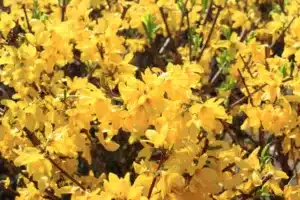
Ideal Countries: Forsythia is grown in many countries around the world, including the United States, Canada, China, and Japan. The plant thrives in temperate climates and can tolerate cold temperatures and frost.
Maintenance Tips: Forsythia is a relatively low-maintenance plant, but here are some tips to ensure its success:
- Watering: Forsythia prefers consistently moist soil, especially during the growing season. However, avoid overwatering, as this can cause root rot.
- Pruning: Forsythia blooms on old wood, so pruning should be done immediately after flowering to avoid removing next year’s buds. Remove any dead or damaged wood, and thin out any crowded or crossing branches.
- Fertilizing: Forsythia does not require much fertilizer, but a light application of a balanced fertilizer in the early spring can promote healthy growth and blooming.
- Pest Control: Forsythia is relatively resistant to pests and diseases. However, it can be susceptible to spider mites and aphids. Regularly inspect your plants for signs of infestation and treat as necessary with an appropriate insecticide.
- Winter Care: Forsythia is hardy and can tolerate cold temperatures, but it should be protected from harsh winds and heavy snowfall. In colder climates, consider wrapping the plant in burlap or providing a windbreak.
In conclusion, Forsythia is a beautiful and easy-to-grow shrub that can add a burst of color to your garden in early spring. With proper planting, watering, pruning, and maintenance, you can enjoy the stunning blooms of the Forsythia year after year.
5. Foxglove
The Foxglove is a biennial or perennial flowering plant that belongs to the Plantaginaceae family. The plant is native to Europe, but it is now widely cultivated around the world for its beautiful blooms. Foxglove flowers come in a range of colors, including pink, white, and purple, and they have distinctive tubular shapes. The plant is known for its medicinal properties and is used to treat heart conditions.
Planting Guide: Foxgloves can be planted in the spring or fall, depending on the climate. The plant prefers well-draining soil and partial shade, although it can tolerate full sun in cooler climates. When planting, sow the seeds directly into the soil or transplant seedlings into the garden. Space the plants 12 to 18 inches apart, and water them regularly until they become established. Foxgloves typically bloom in their second year of growth.
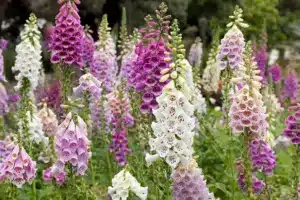
Ideal Countries: Foxgloves are grown in many countries around the world, including the United States, Canada, the United Kingdom, and Australia. The plant thrives in cool, temperate climates and can be found in many gardens and natural areas.
Maintenance Tips: Foxgloves require regular maintenance to ensure their continued health and beauty. Here are some tips:
- Watering: Foxgloves require regular watering, especially during the growing season. Keep the soil consistently moist, but avoid overwatering, which can cause root rot.
- Fertilizing: Foxgloves benefit from regular fertilization during the growing season. Use a balanced fertilizer every two to three weeks to promote healthy growth and blooming.
- Deadheading: Remove spent flowers regularly to encourage the plant to produce more blooms and prevent self-seeding.
- Pest Control: Foxgloves are relatively resistant to pests and diseases, but they can be susceptible to rust, powdery mildew, and aphids. Regularly inspect your plants for signs of infestation and treat as necessary with an appropriate fungicide or insecticide.
- Winter Care: In colder climates, foxgloves may require protection during the winter months. Mulch the soil around the plant to protect the roots, or cover the plant with a layer of straw or burlap.
In conclusion, the Foxglove is a stunning and versatile plant that can add beauty and medicinal benefits to your garden. With proper planting, watering, fertilizing, pruning, and pest control, you can enjoy the unique and elegant blooms of the Foxglove year after year.
6. Fairy Slipper
The Fairy Slipper, also known as Calypso bulbosa, is a beautiful and delicate wildflower that belongs to the Orchidaceae family. The plant is native to North America and can be found in many parts of the United States and Canada. Fairy Slippers are small, with a single stem and a single, slipper-shaped flower that can range in color from pink to purple.
Planting Guide: Fairy Slippers are a wildflower and do not typically require planting, as they grow naturally in the wild. If you wish to plant them in your garden, they can be transplanted from their natural habitat in the early spring, while the plant is still dormant. Choose a site with well-draining soil and partial to full shade. Fairy Slippers prefer cool, moist conditions and should be watered regularly to maintain soil moisture.
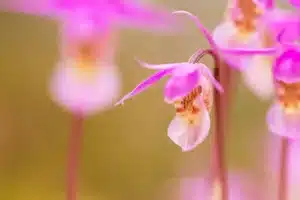
Ideal Countries: Fairy Slippers are native to North America and can be found in many parts of the United States and Canada, including the Pacific Northwest, the Rocky Mountains, and the Northeast. They thrive in cool, moist climates and can be found in shaded areas of forests, meadows, and other natural habitats.
Maintenance Tips: Fairy Slippers are a low-maintenance plant, but here are some tips to ensure their success:
- Watering: Fairy Slippers prefer cool, moist conditions and should be watered regularly to maintain soil moisture. Avoid overwatering, which can cause root rot.
- Fertilizing: Fairy Slippers do not require fertilizer, as they obtain their nutrients from the soil.
- Mulching: Mulch around the base of the plant to help retain moisture and keep the soil cool.
- Pest Control: Fairy Slippers are relatively resistant to pests and diseases. However, they can be susceptible to slugs and snails. Regularly inspect your plants for signs of infestation and treat as necessary with an appropriate pesticide.
- Propagation: Fairy Slippers can be propagated by seed or division. However, they are best left to grow in their natural habitat, as they are a protected species in some areas.
In conclusion, the Fairy Slipper is a delicate and beautiful wildflower that can add a touch of natural beauty to your garden. With proper planting, watering, mulching, and pest control, you can enjoy the unique and elegant blooms of the Fairy Slipper. However, it is important to remember that Fairy Slippers are a protected species in some areas and should be left to grow in their natural habitat whenever possible.
7. Fireweed
The Fireweed, also known as Epilobium angustifolium, is a wildflower that is native to North America, Europe, and Asia. The plant is known for its tall, spiky stems and vibrant pink to purple flowers that bloom in late summer. Fireweed is an important source of nectar for bees and other pollinators and is also used as a medicinal herb.
Planting Guide: Fireweed is typically propagated by seed and can be sown in the spring or fall. The plant prefers well-draining soil and full sun to partial shade. When planting, scatter the seeds on the soil surface and cover lightly with soil. Keep the soil consistently moist until the seeds germinate, which can take up to four weeks. Fireweed can also spread by rhizomes and can become invasive in some areas.
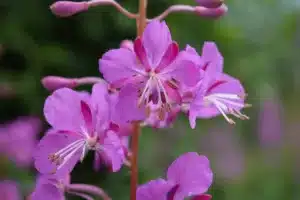
Ideal Countries: Fireweed is found throughout North America, Europe, and Asia, in areas with moist soil and full sun. The plant thrives in disturbed areas, such as clearcuts, burned areas, and along roadsides.
Maintenance Tips: Fireweed is a relatively low-maintenance plant, but here are some tips to ensure its success:
- Watering: Fireweed prefers consistently moist soil, especially during the growing season. However, it can tolerate dry conditions once established.
- Fertilizing: Fireweed does not require much fertilizer, as it can fix its own nitrogen. However, a light application of a balanced fertilizer in the spring can promote healthy growth and blooming.
- Deadheading: Remove spent flowers regularly to encourage the plant to produce more blooms and prevent self-seeding.
- Pest Control: Fireweed is relatively resistant to pests and diseases. However, it can be susceptible to aphids and leaf miners. Regularly inspect your plants for signs of infestation and treat as necessary with an appropriate insecticide.
- Propagation: Fireweed can be propagated by seed or division. However, it can become invasive in some areas, so it is important to monitor its spread and prevent it from taking over other areas of your garden.
In conclusion, Fireweed is a beautiful and important wildflower that can add color and interest to your garden. With proper planting, watering, fertilizing, pruning, and pest control, you can enjoy the stunning blooms of the Fireweed year after year. However, it is important to remember that Fireweed can become invasive in some areas and should be monitored carefully.
8. Four O’Clocks
The Four O’Clocks, also known as Mirabilis jalapa, are a colorful and fragrant perennial flower that is native to South America. The plant is known for its trumpet-shaped flowers that bloom in the late afternoon or early evening and release a sweet fragrance. Four O’Clocks come in a range of colors, including pink, red, yellow, white, and bi-colored.
Planting Guide: Four O’Clocks can be planted in the spring after the last frost or in the fall. The plant prefers well-draining soil and full sun to partial shade. When planting, sow the seeds directly into the soil or transplant seedlings into the garden. Space the plants 12 to 18 inches apart, and water them regularly until they become established. Four O’Clocks can tolerate drought but prefer regular watering during the growing season.
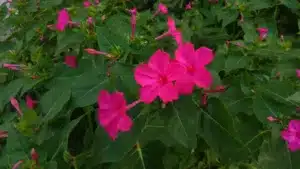
Ideal Countries: Four O’Clocks are grown in many countries around the world, including the United States, Mexico, and South America. The plant thrives in warm climates and can be found in gardens and natural areas throughout these regions.
Maintenance Tips: Four O’Clocks are a low-maintenance plant, but here are some tips to ensure their success:
- Watering: Four O’Clocks prefer regular watering during the growing season, but they can tolerate drought. However, avoid overwatering, which can cause root rot.
- Fertilizing: Four O’Clocks benefit from regular fertilization during the growing season. Use a balanced fertilizer every two to three weeks to promote healthy growth and blooming.
- Deadheading: Remove spent flowers regularly to encourage the plant to produce more blooms.
- Pest Control: Four O’Clocks are relatively resistant to pests and diseases. However, they can be susceptible to spider mites and aphids. Regularly inspect your plants for signs of infestation and treat as necessary with an appropriate insecticide.
- Winter Care: In colder climates, Four O’Clocks will die back to the ground in the winter. Mulch around the base of the plant to protect the roots and provide insulation during the winter months.
In conclusion, Four O’Clocks are a beautiful and fragrant plant that can add color and interest to your garden. With proper planting, watering, fertilizing, pruning, and pest control, you can enjoy the unique and elegant blooms of the Four O’Clocks year after year.
9. False Solomon’s Seal
The False Solomon’s Seal, also known as Maianthemum racemosum, is a perennial plant that is native to North America. The plant is known for its graceful arching stems, which are adorned with small, white, star-shaped flowers in the spring. The plant gets its name from its resemblance to the Solomon’s Seal, which has a similar appearance but is not closely related. False Solomon’s Seal produces red berries in the summer, which are a food source for birds and other wildlife.
Planting Guide: False Solomon’s Seal can be planted in the spring or fall, depending on the climate. The plant prefers well-draining soil and partial to full shade. When planting, dig a hole that is slightly larger than the root ball and place the plant in the hole. Backfill the hole with soil and water the plant well. False Solomon’s Seal can be propagated by division in the fall or early spring.
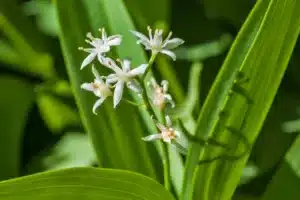
Ideal Countries: False Solomon’s Seal is found throughout North America, in shady areas of forests, woodlands, and meadows. The plant thrives in cool, moist conditions and can be found in many natural habitats throughout the continent.
Maintenance Tips: False Solomon’s Seal is a relatively low-maintenance plant, but here are some tips to ensure its success:
- Watering: False Solomon’s Seal prefers consistently moist soil, especially during the growing season. However, avoid overwatering, which can cause root rot.
- Fertilizing: False Solomon’s Seal does not require much fertilizer, as it can obtain its nutrients from the soil. However, a light application of a balanced fertilizer in the spring can promote healthy growth.
- Pruning: False Solomon’s Seal does not require pruning, but you can remove any dead or damaged foliage to maintain the plant’s appearance.
- Pest Control: False Solomon’s Seal is relatively resistant to pests and diseases. However, it can be susceptible to slugs and snails. Regularly inspect your plants for signs of infestation and treat as necessary with an appropriate pesticide.
- Winter Care: False Solomon’s Seal is hardy and can tolerate cold temperatures. In colder climates, the plant will die back to the ground in the winter and emerge again in the spring.
In conclusion, False Solomon’s Seal is a beautiful and easy-to-grow plant that can add a touch of elegance to your garden.
10. Featherfew
The Feverfew, also known as Tanacetum parthenium, is a herbaceous perennial plant that is native to Eurasia, but now widely cultivated throughout the world. The plant is known for its small, daisy-like flowers that bloom throughout the summer and its strong, distinct fragrance. Feverfew has been used for centuries as a natural remedy for headaches, fevers, and arthritis.
Planting Guide: Feverfew can be planted in the spring or fall, depending on the climate. The plant prefers well-draining soil and full sun to partial shade. When planting, sow the seeds directly into the soil or transplant seedlings into the garden. Space the plants 12 to 18 inches apart, and water them regularly until they become established. Feverfew requires regular watering, especially during the growing season, but can tolerate drought conditions.

Ideal Countries: Feverfew is found throughout Eurasia and has been naturalized in many other parts of the world. The plant thrives in temperate climates and can be found in gardens, natural areas, and along roadsides throughout these regions.
Maintenance Tips: Feverfew is a relatively low-maintenance plant, but here are some tips to ensure its success:
- Watering: Feverfew requires regular watering, especially during the growing season. However, avoid overwatering, which can cause root rot.
- Fertilizing: Feverfew does not require much fertilizer, as it can obtain its nutrients from the soil. However, a light application of a balanced fertilizer in the spring can promote healthy growth and blooming.
- Deadheading: Remove spent flowers regularly to encourage the plant to produce more blooms.
- Pest Control: Feverfew is relatively resistant to pests and diseases. However, it can be susceptible to aphids and spider mites. Regularly inspect your plants for signs of infestation and treat as necessary with an appropriate insecticide.
- Harvesting: Feverfew can be harvested throughout the growing season for its medicinal properties. Harvest the leaves and flowers in the morning, before the heat of the day, and dry them in a warm, dry place.
In conclusion, Feverfew is a versatile and beneficial herb that can add beauty and natural remedies to your garden. With proper planting, watering, fertilizing, pruning, and pest control, you can enjoy the unique and fragrant blooms of the Feverfew throughout the growing season. Whether you’re looking for a natural remedy for headaches and fevers, or simply want to add a touch of beauty to your garden, the Feverfew is a great choice.
11. Feverfew
The Feverfew, also known as Tanacetum parthenium, is a medicinal herb that belongs to the Asteraceae family. The plant is native to Europe but has been naturalized in many parts of the world. Feverfew is known for its small, daisy-like flowers and strong fragrance, and has been used for centuries as a natural remedy for headaches, migraines, and arthritis.
Planting Guide: Feverfew is typically propagated by seed and can be sown in the spring or fall. The plant prefers well-draining soil and full sun to partial shade. When planting, sow the seeds directly into the soil or transplant seedlings into the garden. Space the plants 12 to 18 inches apart, and water them regularly until they become established. Feverfew requires regular watering, especially during the growing season, but can tolerate drought conditions.
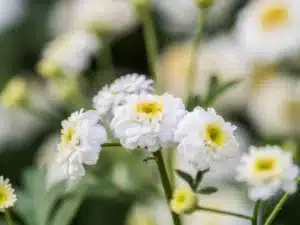
Ideal Countries: Feverfew is found throughout Europe and has been naturalized in many other parts of the world, including North America and Australia. The plant thrives in temperate climates and can be found in gardens, natural areas, and along roadsides throughout these regions.
Maintenance Tips: Feverfew is a relatively low-maintenance plant, but here are some tips to ensure its success:
- Watering: Feverfew requires regular watering, especially during the growing season. However, avoid overwatering, which can cause root rot.
- Fertilizing: Feverfew does not require much fertilizer, as it can obtain its nutrients from the soil. However, a light application of a balanced fertilizer in the spring can promote healthy growth and blooming.
- Deadheading: Remove spent flowers regularly to encourage the plant to produce more blooms.
- Pest Control: Feverfew is relatively resistant to pests and diseases. However, it can be susceptible to aphids and spider mites. Regularly inspect your plants for signs of infestation and treat as necessary with an appropriate insecticide.
- Harvesting: Feverfew can be harvested throughout the growing season for its medicinal properties. Harvest the leaves and flowers in the morning, before the heat of the day, and dry them in a warm, dry place.
To sum up, the Feverfew is a highly beneficial and adaptable herb that can be effortlessly cultivated in your garden. With adequate care including planting, watering, fertilizing, pruning, and pest control, you can relish the charming and aromatic flowers of the Feverfew throughout the growing season.
Whether you are searching for a natural solution for headaches and migraines or just want to enhance the beauty of your garden, the Feverfew is an exceptional selection.
Therefore, why not commence planting your own Feverfew today and take advantage of the remarkable properties of this wonderful plant?
12. Flaming Katy
The Flaming Katy, also known as Kalanchoe blossfeldiana, is a popular houseplant that is native to Madagascar. The plant is known for its striking, brightly colored flowers that bloom in clusters atop dark green, glossy leaves. Flaming Katy comes in a range of colors, including red, pink, orange, yellow, and white.
Planting Guide: Flaming Katy can be planted in pots or containers indoors. The plant prefers well-draining soil and bright, indirect sunlight. When planting, use a pot with drainage holes to allow excess water to escape. Water the plant only when the soil is dry to the touch, as Flaming Katy is sensitive to overwatering. Flaming Katy can be propagated from stem cuttings in the spring or summer.

Ideal Countries: Flaming Katy is native to Madagascar but is widely cultivated throughout the world. The plant thrives in warm, dry conditions and is often grown indoors as a houseplant.
Maintenance Tips: Flaming Katy is a relatively low-maintenance plant, but here are some tips to ensure its success:
- Watering: Flaming Katy prefers dry soil and is sensitive to overwatering. Water the plant only when the soil is dry to the touch.
- Fertilizing: Flaming Katy does not require much fertilizer, as it can obtain its nutrients from the soil. However, a light application of a balanced fertilizer in the spring can promote healthy growth and blooming.
- Deadheading: Remove spent flowers regularly to encourage the plant to produce more blooms.
- Pruning: Flaming Katy can be pruned to control its size and shape. Prune the plant in the spring or early summer to encourage branching and bushier growth.
- Pest Control: Flaming Katy is relatively resistant to pests and diseases. However, it can be susceptible to mealybugs and spider mites. Regularly inspect your plants for signs of infestation and treat as necessary with an appropriate insecticide.
In conclusion, Flaming Katy is a beautiful and vibrant houseplant that can brighten up any indoor space. With proper planting, watering, fertilizing, pruning, and pest control, you can enjoy the unique and colorful blooms of the Flaming Katy throughout the year. Whether you’re an experienced gardener or a beginner, the Flaming Katy is an excellent choice for a rewarding and low-maintenance indoor plant.
13. Flowering Quince
The Flowering Quince, also known as Chaenomeles speciosa, is a deciduous shrub that is native to Asia. The plant is known for its beautiful, early-spring blooms that appear before the foliage emerges. The flowers come in shades of pink, red, and white, and are followed by small, edible fruit in the fall. The Flowering Quince also has thorny branches that make it an excellent choice for a natural barrier or hedge.
Planting Guide: Flowering Quince can be planted in the fall or spring, depending on the climate. The plant prefers well-draining soil and full sun to partial shade. When planting, dig a hole that is slightly larger than the root ball and place the plant in the hole. Backfill the hole with soil and water the plant well. Flowering Quince can be propagated by cuttings or layering in the fall or early spring.
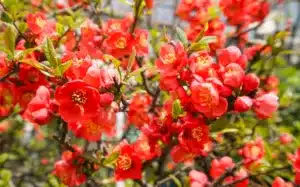
Ideal Countries: Flowering Quince is found throughout Asia, but is also grown as an ornamental plant in many parts of the world. The plant thrives in temperate climates and can be found in gardens and natural areas throughout these regions.
Maintenance Tips: Flowering Quince is a relatively low-maintenance plant, but here are some tips to ensure its success:
- Watering: Flowering Quince requires regular watering, especially during the growing season. However, avoid overwatering, which can cause root rot.
- Fertilizing: Flowering Quince does not require much fertilizer, but a light application of a balanced fertilizer in the spring can promote healthy growth and blooming.
- Pruning: Flowering Quince can be pruned in the late winter or early spring to control its size and shape. Remove any dead, damaged, or diseased branches, and thin out the plant to promote air circulation.
- Pest Control: Flowering Quince is relatively resistant to pests and diseases. However, it can be susceptible to aphids and spider mites. Regularly inspect your plants for signs of infestation and treat as necessary with an appropriate pesticide.
- Winter Care: Flowering Quince is hardy and can tolerate cold temperatures. In colder climates, the plant may lose its leaves in the winter and emerge again in the spring.
To sum up, the Flowering Quince is an adaptable and visually appealing shrub that can infuse your garden with color and vitality.
By ensuring that the plant is planted, watered, fertilized, pruned, and protected from pests in the right way, you can admire its beautiful and one-of-a-kind blooms every year.
Whether you wish to incorporate a natural barrier or hedge or just want to enhance the aesthetic value of your garden, the Flowering Quince is an excellent selection that is sure to satisfy your requirements.
14. French Marigold
The French Marigold, also known as Tagetes patula, is an annual flowering plant that is native to Mexico and Central America. The plant is known for its bright, showy flowers that come in shades of orange, yellow, and red. The flowers are daisy-like and have a distinctive, spicy scent. French Marigold is often grown as a border plant or in containers, and is also used for its pest-repelling properties.
Planting Guide: French Marigold can be planted in the spring after the danger of frost has passed. The plant prefers well-draining soil and full sun to partial shade. When planting, sow the seeds directly into the soil or transplant seedlings into the garden. Space the plants 6 to 8 inches apart, and water them regularly until they become established. French Marigold does not require much water and can tolerate drought conditions.
Ideal Countries: French Marigold is found throughout Mexico and Central America, but is now widely cultivated throughout the world. The plant thrives in warm, sunny climates and is often grown in gardens and containers in these regions.
Maintenance Tips: French Marigold is a relatively low-maintenance plant, but here are some tips to ensure its success:
- Watering: French Marigold does not require much water and can tolerate drought conditions. Water the plant only when the soil is dry to the touch.
- Fertilizing: French Marigold does not require much fertilizer, but a light application of a balanced fertilizer in the spring can promote healthy growth and blooming.
- Deadheading: Remove spent flowers regularly to encourage the plant to produce more blooms.
- Pest Control: French Marigold is often grown for its pest-repelling properties, but can also be susceptible to aphids and spider mites. Regularly inspect your plants for signs of infestation and treat as necessary with an appropriate insecticide.
- Harvesting: French Marigold does not have any edible uses, but can be harvested for its dried flowers. Harvest the flowers in the morning, before the heat of the day, and dry them in a warm, dry place.
In conclusion, French Marigold is a bright and fragrant annual plant that is perfect for adding color to your garden or container. With proper planting, watering, fertilizing, pruning, and pest control, you can enjoy the unique and vibrant blooms of the French Marigold throughout the growing season.
Whether you’re looking for a natural pest-repelling solution or simply want to add a touch of beauty to your garden, the French Marigold is an excellent choice. So, start growing your own French Marigold today and enjoy the benefits of this lovely and low-maintenance plant!
FAQs For French Marigolds
What Is The Difference Between Marigold and French Marigolds?
Marigolds are a broad category of flowering plants that belong to the Tagetes genus. There are several species of marigolds, including African Marigolds (Tagetes erecta), French Marigolds (Tagetes patula), and Mexican Marigolds (Tagetes erecta). Each of these species has unique characteristics that distinguish them from one another.
French Marigolds, or Tagetes patula, are a specific type of marigold that is known for its smaller size and intricate, daisy-like flowers. French Marigolds typically grow to be around 6-12 inches tall, and have flowers that are around 1-2 inches wide. They come in a variety of colors, including yellow, orange, red, and maroon, and have a distinctive, spicy scent.
African Marigolds, or Tagetes erecta, are a larger type of marigold that typically grow to be around 2-3 feet tall. They have larger flowers than French Marigolds, which can be up to 4 inches wide, and come in a range of colors including yellow, orange, and maroon. African Marigolds have a more pungent odor than French Marigolds, which can be unpleasant to some people.
Mexican Marigolds, or Tagetes lucida, are a type of marigold that is native to Mexico and Central America. They are known for their strong, anise-like scent and are often used in cooking and medicinal purposes. Mexican Marigolds are typically smaller than African Marigolds, but larger than French Marigolds, and have flowers that range in color from yellow to orange.
In summary, French Marigolds are a specific type of marigold that is known for its smaller size and intricate, daisy-like flowers, while other species of marigolds like African Marigolds and Mexican Marigolds have their own unique characteristics that differentiate them from French Marigolds.
Do French Marigolds Multiply?
French marigolds are annual plants, meaning they complete their life cycle in one growing season and do not typically multiply by themselves. However, French marigolds can produce a large number of seeds that can be collected and sown in the following growing season.
If you allow the flowers to go to seed and collect the seeds before they fall to the ground, you can propagate the plants by planting the seeds the following year.
Alternatively, you can also propagate French marigolds through stem cuttings, but this process can be more challenging and may require rooting hormone to encourage successful rooting.
In general, French marigolds are easy to grow from seed and can provide a colorful and fragrant addition to your garden or container.
15. Forget-Me-Not
The Forget-Me-Not, or Myosotis, is a delicate, herbaceous perennial plant that is native to Europe and Asia. The plant is known for its small, sky-blue flowers that have a distinctive yellow center. Forget-Me-Nots grow to be around 6-12 inches tall and have small, hairy leaves that grow in a rosette pattern. The plant is often used as an ornamental plant in gardens and natural areas.
Planting Guide: Forget-Me-Nots can be planted in the spring or fall. The plant prefers moist, well-draining soil and partial to full shade. When planting, sow the seeds directly into the soil or transplant seedlings into the garden. Space the plants 6 to 8 inches apart, and water them regularly until they become established. Forget-Me-Nots can be propagated by division in the fall or early spring.

Ideal Countries: Forget-Me-Nots are native to Europe and Asia but are now widely cultivated throughout the world. The plant thrives in temperate climates and is often grown in gardens and natural areas in these regions.
Maintenance Tips: Forget-Me-Nots are relatively low-maintenance plants, but here are some tips to ensure their success:
- Watering: Forget-Me-Nots prefer moist soil and require regular watering. However, avoid overwatering, which can cause root rot.
- Fertilizing: Forget-Me-Nots do not require much fertilizer, but a light application of a balanced fertilizer in the spring can promote healthy growth and blooming.
- Deadheading: Remove spent flowers regularly to encourage the plant to produce more blooms.
- Pruning: Forget-Me-Nots do not require pruning, but can be cut back after flowering to encourage bushier growth.
- Pest Control: Forget-Me-Nots are relatively resistant to pests and diseases. However, they can be susceptible to powdery mildew. Regularly inspect your plants for signs of infestation and treat as necessary with an appropriate fungicide.
In conclusion, Forget-Me-Nots are a delicate and charming perennial plant that can add beauty and interest to your garden or natural area.
Whether you’re looking for a plant to use as ground cover or simply want to add a touch of color to your garden, the Forget-Me-Not is an excellent choice. So, start growing your own Forget-Me-Nots today and enjoy the benefits of this beautiful and low-maintenance plant!
And There Are Your Flowers Starting With F
And that’s a wrap, folks! We hope you enjoyed our little tour of Flowers Starting with F.
Whether you’re a seasoned gardener or just getting started, we’re sure you’ve found some new favorites to add to your collection. But hey, we’re always up for discovering new blooms, so feel free to share any other F-flowers that you think should have made the cut in the comments below.
And in the meantime, Happy Gardening! May your gardens bloom plentifully and your watering cans never run dry.

Hi there, I’m Mark Apletree, a gardening enthusiast with a passion for gardening, and gardening tools. I’ll be your go-to guide for all things related to gardening. The purpose of this website is to assist you in selecting the most suitable garden gear that meets your specific requirements.
See All Posts

